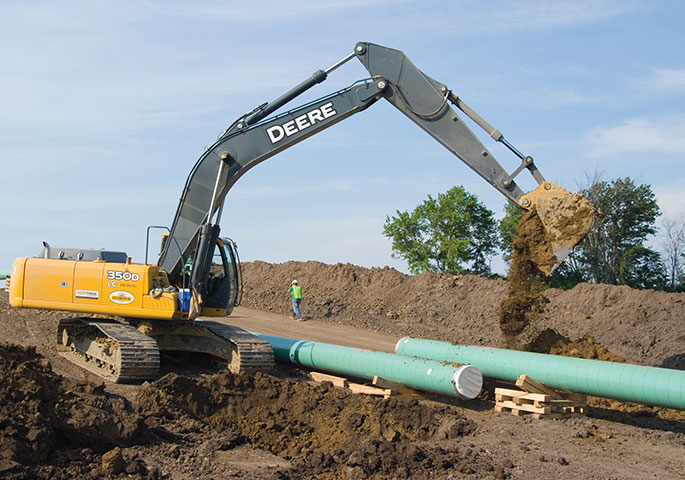January 2018 Vol. 73 No. 1
Features
Will Oil Production, Natural Gas Price Upticks Lead To Pipeline Growth?

By Michael Reed, Contributing Editor
While pointing to Hurricane Harvey as the reason for some ambiguity concerning oil prices in the short term, recent Energy Information Administration (EIA) projections have trended favorably for the pipeline industry in the coming year.
In fact, with many Gulf of Mexico platforms already back in operation by late 2017, U.S. crude oil production should average 9.8 MMbpd in 2018 – up from 9.3 MMbpd in 2017, and the highest annual mark in U.S. history. That would surpass the record of 9.6 MMbpd from 1970, EIA said in its Sept. 12 Short-Term Energy Outlook (STEO).
Moreover, Brent crude prices are expected to rise to $52 a barrel in 2018, while West Texas Intermediate (WTI) will average about $2 less. Additionally, natural gas production is forecasted by EIA to average 73.3 Bcf/d by the end of the year – a 1.4 Bcf/d increase from 2016 – with production in 2018 forecasted to be 4.4 Bcf/d more than 2018.
“If all goes smoothly, 2018 will likely be a banner year for pipeline construction,” said Cathy Landry, vice president, Communications, of the Interstate Natural Gas Association of America (INGAA). “A lot of projects are getting close to final decision by FERC (Federal Energy Regulatory Commission), which means that operators and contractors could be working full out next year.”
Landry’s assessment of the coming year is supported by energy analysts at PointLogic Energy, who confirmed 31 projects in North America that are on track to be in-service by year-end. All together, these will account for about 14 Bcf/d of natural gas.
PointLogic said central to the growth will be Appalachia, where over one-third of the projects cited – Rover and Atlantic Sunrise among them – will provide transportation gas out of the Marcellus and Utica shales. Meanwhile, other projects are already using gas locally in producing areas for more localized needs, with several other such projects coming into service in 2018 and 2019.
“Pipeline development continues to grow due to expanding oil and gas production in key areas, including the Marcellus and Utica, Permian Basin and the Scoop/Stack plays in Oklahoma,” said Paul Moran, associate director at Navigant. “Over the next year, key developments to monitor include the ongoing battle between FERC and state regulators in the Northeast, in addition to announcements of new projects for oil, gas and NGL pipelines in the Permian and in the Oklahoma Scoop/Stack plays.”
Gas prices, supplies
In August, the average Henry Hub natural gas spot price was $2.90 per MMBtu, down 8 cents/MMBtu from the July level. However, anticipated expansion in natural gas exports and domestic natural gas consumption in 2018 contribute to the forecast that Henry Hub natural gas spot price will rise from an annual average of $3.05/MMBtu in 2017 to $3.29/MMBtu in 2018.
That domestic natural gas supply will continue to grow, due to the advancement of key technologies that unlock gas production from reservoirs such as shale formations, is evidenced by a recent American Gas Associated-coordinated report. In it, the Potential Gas Committee of the Colorado School of Mines stated the United States has a technically recoverable natural gas resource base of 2,817 Tcf yet to be discovered. This is the highest resource evaluation in the committee’s 52-year history – a 12 percent increase from the previous high assessment at year-end 2014.
The increasing importance of shale gas in the U.S. is further evidenced by the report’s mean total assessed shale gas resource of 1,797 Tcf for 2016, which accounted for 64 percent of the country’s total potential resources.
In other words, the potential for an increasing number of new projects exists for the coming year, but so do the trials that will accompany any expansion.
“That, of course, brings challenges, including ensuring there are enough crews to do all the work,” Landry said. “Construction contractors have indicated that they are ready to get to work on the projects, which will bring much-needed natural gas to markets.”
In its Sept. 25 outlook, Moody’s Investors Service pointed to “an expected slowdown” in the pace of earnings growth on the global integrated oil and gas industry following strong earnings recovery in 2017 as a return to “stable, organic growth.”
“The sector’s return to positive free cash flow generation in 2017 will boost the capacity of European majors to reinstate full cash dividends over the next 12-18 months,” Moody’s wrote. “While higher shareholder returns would put a brake on further improvement in credit metric in 2018, the companies can maintain their recovered credit profiles.”




Comments